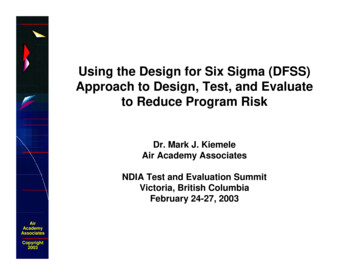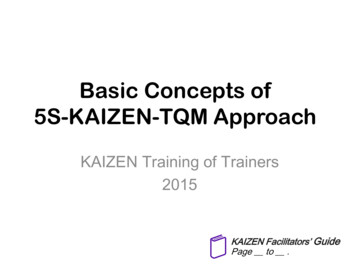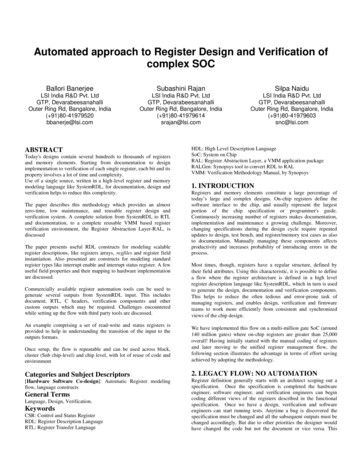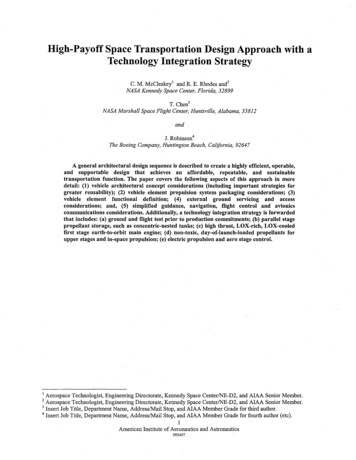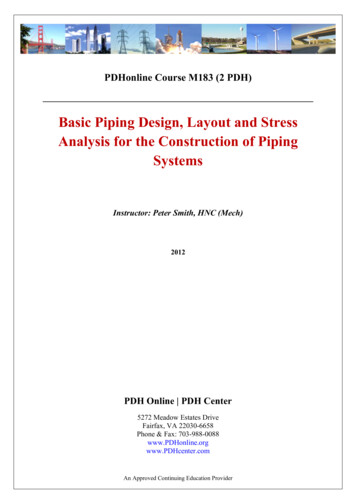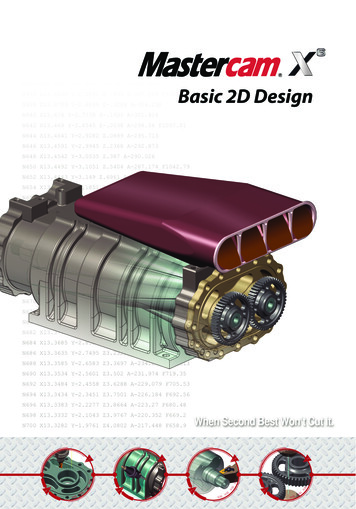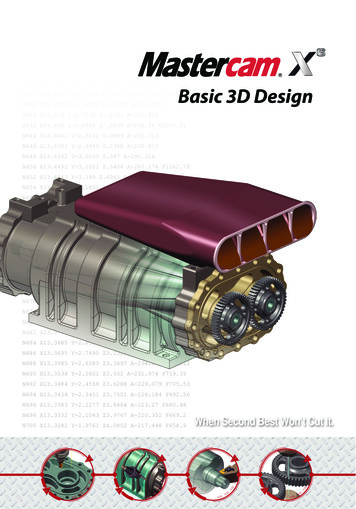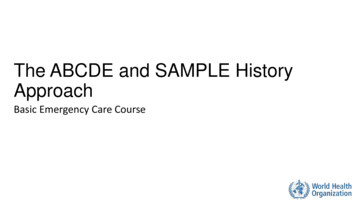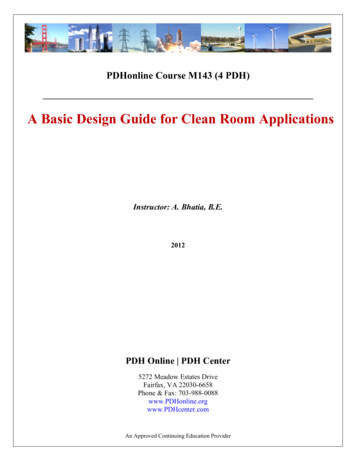
Transcription
PDHonline Course M143 (4 PDH)A Basic Design Guide for Clean Room ApplicationsInstructor: A. Bhatia, B.E.2012PDH Online PDH Center5272 Meadow Estates DriveFairfax, VA 22030-6658Phone & Fax: 703-988-0088www.PDHonline.orgwww.PDHcenter.comAn Approved Continuing Education Provider
www.PDHcenter.comPDH Course M143www.PDHonline.orgA Basic Design Guide for Clean Room ApplicationsCourse ContentPART – IOVERVIEWClean rooms are defined as specially constructed, environmentally controlled enclosed spaceswith respect to airborne particulates, temperature, humidity, air pressure, airflow patterns, airmotion, vibration, noise, viable (living) organisms, and lighting. Particulate control includes:!" Particulate and microbial contamination!" Particulate concentration and dispersion“Federal Standard 209E” defines a clean room as a room in which the concentration of airborneparticles is controlled to specified limits.“British Standard 5295” defines a clean room as a room with control of particulate contamination,constructed and used in such a way as to minimize the introduction, generation and retention ofparticles inside the room and in which the temperature, humidity, airflow patterns, air motion andpressure are controlled.Today, many manufacturing processes require that spaces be designed to control particulate andmicrobial contamination while maintaining reasonable installation and operating costs. Cleanrooms are typically used in manufacturing, packaging, and research facilities associated withthese industries:1. Semiconductor: This industry drives the state of the art clean room design, and thisindustry accounts for a significant number of all operating clean rooms.2. Pharmaceutical: Clean rooms control living particles that would produce undesirablebacterial growth in the preparation of biological, pharmaceutical, and other medicalproducts as well as in genetic engineering research.Page 1 of 61
www.PDHcenter.comPDH Course M143www.PDHonline.org3. Aerospace: The manufacturing and assembling of aerospace electronics, missiles andsatellites were the first application of clean rooms. Large volume clean room spaces withextreme cleanliness are involved.4. Miscellaneous Applications: Other uses include advanced materials research, laser andoptic industries, microelectronics facility, paint room and in some aseptic foodsproduction. Also in some high infection risk areas of hospitals.While hospital operating rooms can be considered clean spaces, their concern is to control typesof contamination rather than the quantity of particles present. The semiconductor manufacturingrequires very clean environment.Sources of contaminationThe source of the contamination is categorized as external sources and internal sources.A. External Sources - For any given space, there exists the external influence of grossatmospheric contamination. External contamination is brought in primarily through the airconditioning system through makeup air. Also, external contamination can infiltratethrough building doors, windows, cracks, and wall penetrations for pipes, cables andducts. The external contamination is controlled primarily by1. High efficiency filtration,2. Space pressurization and3. Sealing of space penetrationsB. Internal Sources- The potentially largest source is from people in the clean room, plusshedding of surfaces, process equipment and the process itself. People in the workspacegenerate particles in the form of skin flakes, lint, cosmetics, and respiratory emissions.Industry generates particles from combustion processes, chemical vapors, solderingfumes, and cleaning agents. Other sources of internal contamination are generatedthrough the activity in combustion, chemical, and manufacturing processes. The size ofPage 2 of 61
www.PDHcenter.comPDH Course M143www.PDHonline.orgthese particles ranges from 0.001 to several hundred microns. Particles larger than 5microns tend to settle quickly unless air blown. The greatest concern is that the actualparticle deposits on the product.Control is primarily through airflow design. Although airflow design is critical, it alone doesnot guarantee that clean room conditions will be met. Construction finishes; personneland garments; materials and equipments are sources of particulate contamination thatmust be controlled. Important control precautions include:1. Walls, floors, ceiling tiles, lighting fixtures, doors, and windows are constructionmaterials that must be carefully selected to meet clean room standards.2. People must wear garments to minimize the release of particles into the space.The type of garments depends on the level of cleanliness required by a process.Smocks, coveralls, gloves, and head and shoe covers are clothing accessoriescommonly used in clean spaces.3. Materials and equipment must be cleaned before entering the clean room.4. Room entrances such as air locks and pass-through are used to maintainpressure differentials and reduce contaminants.5. Air showers are used to remove contaminants from personnel before entering theclean space.Application GuidelinesThe industry differentiates between the cleanliness of rooms by referring to class numbers.Federal Standard 209E, “Airborne Particulate Cleanliness Classes in Clean Rooms and CleanZones”, September 11, 1992, categorize clean rooms in six general classes, depending on theparticle count (particles per cubic foot) and size in microns ( m). The first three classes allow noparticles exceeding 0.5 microns (m), and the last three allowing some particles up to 5.0 microns.Page 3 of 61
www.PDHcenter.comClean RoomClassPDH Course M143www.PDHonline.orgClass Limits "not to exceed" particles percu ft for particle sizes shown0.1µm 0.2µm 0.3µm 0.5µm 5 ----100000700Interpreting the table above, a class 100,000 clean room limits the concentration of airborneparticles equal to or greater than 0.5 microns to 1 00,000 particles in a cubic foot of air.ISO/TC209 clean room class ratings are slowly replacing the Federal Standard 209E ratings.ISO/TC209 is based on metric measurements whereas Federal Standard 209E that is based onimperial measurements. The classes, according to ISO/TC209 14644-1, are in terms of classlevels 3, 4, 5 of airborne particulate cleanliness. A Class 5 means that less than 3,520 particles(0.5 microns in size) are present per cubic meter, which equals 100 particles per cubic foot. AClass 6 indicates less than 35,200 particles per cubic meter. The higher the class number, themore are the particles present.Federal Std.209 EISO131041005100061000071000008Page 4 of 61
www.PDHcenter.comPDH Course M143www.PDHonline.orgImportant Regulatory and Guideline Information1. The Institute of Environmental Sciences (IES): Consideration for Clean room Design, IES- RP - CC012.12. Testing Clean Rooms (IES-RP-CC-006-84-T), outlines performance tests procedures.IES-CC-011-85T for Glossary of terms and definitions related to contamination control.3. IES - RP - CC - 006: Testing Clean rooms4. IES - RP - CC007: Testing ULPA Filters5. Fed Std. 209E: Prepared by the Institute for Environmental Sciences, under the authorityof the General Services Administration of the Federal Government offers specificguidelines in terms of non-viable particulate levels.6. Chapter 32 of ASHRAE Guide and data book on Systems and Application, 1997 providesinformation on Clean Spaces.7. ISO / TC 209: Clean room and Associated Controlled Environments8. JIS - B - 9920: Measuring Methods for Airborne Particles in Clean rooms and EvaluatingMethods for Air Cleanliness of Clean rooms; Japanese Standards Association.9. NEBB, Procedural Standards for Certified Testing of Clean rooms (refer part III section 4for details)TerminologyAs-build - A clean room that is complete and ready for operation, with all services connected andfunctional, but without production equipment or personnel in the room.Operational - A term used to describe a clean room in normal operation with all servicesfunctioning and with production equipment and personnel present and performing their normalwork functions.Class - The term used to specify the clean room airborne particulate cleanliness level per FS209as 1, 10, 100, 1,000, 10,000, and 100,000 (particles per cubic foot).Page 5 of 61
www.PDHcenter.comPDH Course M143www.PDHonline.orgImportant Design Considerations for HVAC SystemsThe 4 important air-conditioning design considerations for clean room system design are:1. Supplying airflow in sufficient volume and cleanliness to support the cleanliness rating ofthe room.2. Introducing air in a manner to prevent stagnant areas where particles could accumulate.3. Conditioning air to meet clean-room temperature, humidity and filtration requirements.4. Ensuring enough conditioned makeup air to maintain the specified positivepressurization.Besides the room preparation in terms of materials and finishes play an equally important role inmeeting these requirements. The idea is to minimize the internal generation of contaminants fromthe surfaces.What differentiates clean room HVAC to conventional systems?Clean room design encompasses much more than traditional temperature and humidity control.Design must consider aspects such as control of particulate, microbial, electrostatic discharge,gaseous contaminants, airflow pattern control, and pressurization and industrial engineeringaspects.The primary design goal of clean room is the particulate controlThe size of these particles ranges from 0.001 to several hundred microns.Particles of different sizes behave differently as air moves through a room. For example, in aneight-foot high room, a particle in the 50-micron range might take 60 seconds to settle, while a 1micron particle might take 15 hours to settle. Particles larger than 5 microns tend to settle quicklyunless air blown.Page 6 of 61
www.PDHcenter.comPDH Course M143www.PDHonline.orgA clean room differs from an ordinary ventilated/conditioned room mainly in three ways.1. Increased air supply: The increased air supply is an important aspect of particlecontrol. Normal air-conditioning systems are designed for 0.5 to 2 air changes per houressentially based on the occupancy level or as determined from the building exhaustlevels. A clean room would have at least 10 air changes per hour and could be as high as600 for absolute cleanliness. The large air supply is mainly provided to eliminate thesettling of the particulate and dilute contamination produced in the room to an acceptableconcentration level.2. The use of high efficiency filters: High efficiency filters are used to filter the supply airinto a clean room to ensure the removal of small particles. The high efficiency filters usedin clean rooms are installed at the point of air discharge into the room. Roompressurization is mainly provided to ensure that untreated air does not pass from dirtieradjacent areas into the clean room.3. Room pressurization: The clean room is positively pressurized with respect to theadjacent areas. This is done by supplying more air and extracting less air from the roomthan is supplied to it.The greatest concern is that the actual particle deposits on the product, which can spoil it.Before any methods of contamination control of airborne particles can be applied, a decision mustbe made as to how critical this particulate matter is to the process or product. This is done byclassification of room to requisite class level.There is much more than above for instance the type of filtration, efficiency, airflow distributionand patterns, amount of pressurization, redundancy, noise issues etc etc We shall discuss the above further in Part II.Page 7 of 61
www.PDHcenter.comPART – II1PDH Course M143www.PDHonline.orgHVAC DESIGN CONSIDERATIONSFILTRATION (HEPA and ULPA Air Filters)Filtration is an important aspect of clean rooms. Most filters are defined by their particle removalefficiency and airflow rate. Clean rooms require very high efficiency filters and for class 100 andbelow, 100% HEPA filter coverage is recommended. HEPA (High efficiency particulatearrestance) filtration is 40% more efficient than the highest efficiency rated ASHRAE filter.Clean room air filtration technology centers around two types: High efficiency particulate air (HEPA):HEPA filters are replaceable extended-media dry-type having a minimum particlecollective efficiency of 99.97 to 99.997% for a 0.3 micron particle, and a maximum cleanfilter pressure drop of 2.54 cm (1") water gauge when tested at rated air flow capacity. 0.3micron is 1/75,000 of an inch or 1/300, the diameter of the human hair. Ultra low penetration air (ULPA):Most ULPA filters are replaceable extended media dry filters that have a minimumparticle collection efficiency of 99.9997 % efficient for particles greater than or equal to0.12-micron in size.The high efficiency filters belong to the 'interception' family of filters and are referred to as'absolute' super interceptor. Absolute filters are used only where an extremely high level ofcleanliness or purity is required. Both HEPA & ULPA types fall in this category.Typically absolute filters use glass fiber paper technology and are generally constructed in deeppleats with aluminum, coated-string or fiber paper pleating separators. They vary in depth from 2to 12 inches or more.Filtration MechanismsPage 8 of 61
www.PDHcenter.comPDH Course M143www.PDHonline.orgThere are four basic mechanisms in which fibrous air filters remove contamination from theairstreams.1. Straining or Sieving: Particles larger than the clearances between fibers cannot passthrough and are collected on the media.2. Inertial or Impaction: Particles due to their inertia leave the airstream’s around filters andimpact the fiber directly. Adhesives usually retain the particles.3. Interception: Particles small enough follow the airstreams line around the filter fiber butare intercepted by th
Clean room design encompasses much more than traditional temperature and humidity control. Design must consider aspects such as control of particulate, microbial, electrostatic discharge, gaseous contaminants, airflow pattern control, and pressurization and industrial engineering aspects. The primary design goal of clean room is the particulate control The size of these particles ranges from 0 .File Size: 657KBPage Count: 62Explore furtherBasic clean room design requirements and considerationswww.pharmout.netHIGH PERFORMANCE CLEANROOMShightech.lbl.govWhat is a Cleanroom? Cleanroom Classifications, Class 1 .www.cleanairtechnology.comA basic design approach to Clean Roomgmpua.comCleanroom Basics - CERHBcerhb.ufl.eduRecommended to you based on what's popular Feedback
